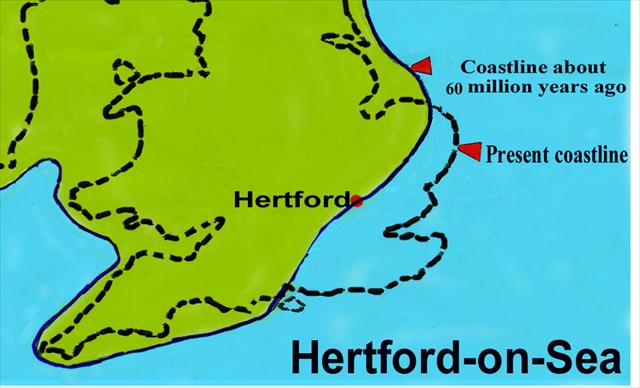Puddingstones in various forms, are found in several regions across the world - the UK, Canada, and the USA, are just some of these regions.
Puddingstones are conglomerates, that is a mixture of coarse and fine grained materials e.g. pebbles and sands, held together in a matrix such as clay, mudstone, or chalky limestone. They take their name from their appearance, which is like that of a plum, or Christmas pudding.
Hertfordshire Puddingstone is a unique, hard form, of Puddingstone, because the cement binding the constituents together is a natural silica cement, and thus very similar in composition to the clasts and the matrix.
This stone was probably formed some 65-60 million years ago, around the Cretaceous, when much of the British Isles was submerged beneath a warm sea, and temperatures were around 10-12C higher than they are today.
Flints were formed within chalk beds from the silica in marine organisms, receding water levels washed away some of the chalk, and the flints were carried down to the sea in rivers. The tumbling motion of the water of the rivers smoothing out their shape, which was then further rounded by wave action on the seashore.
The colouration of the pebbles, and their black rims, is considered to be due to the effects of different oxides of Iron, absorbed into the the pebbles during their formation.
It is thought likely that the silica cement matrix of Hertfordshire Puddingstone, was formed by the warm water dissolving silica from the soil above the chalk layers, this then percolated down and replaced the carbonates of the limestone with silicates.
Thus the pebbles, the fine sand matrix, and the cement, are all basically formed formed from silica, hence the similar hardness across the whole of the Puddingstone.
As the water eventually receded further from the land, the stone dried out, and what was once the shoreline, became an inland area, which is why the Hertfordshire Puddingstone is found some distance from the present day coastline

Because of its hardness and durability, Hertfordshire Puddingstone was used in Roman times as grinding wheels for corn (Quern Stones). It has also been used in small quantities as a building material, and it can be cleanly cut and polished to reveal its distinct colouration.
Before logging this cache, please send us the answers to the questions below
No spoiler photos please
1. Describe the appearance and size of the stone.
2. Why are the flints (pebbles) the shape they are, instead of the more usual angular shape.
3. Given that the density of Hertfordshire Puddingstone is approximately 1225 Kg per cubic metre, estimate the weight of the stone.
Image courtesy of East Herts Geology Club.